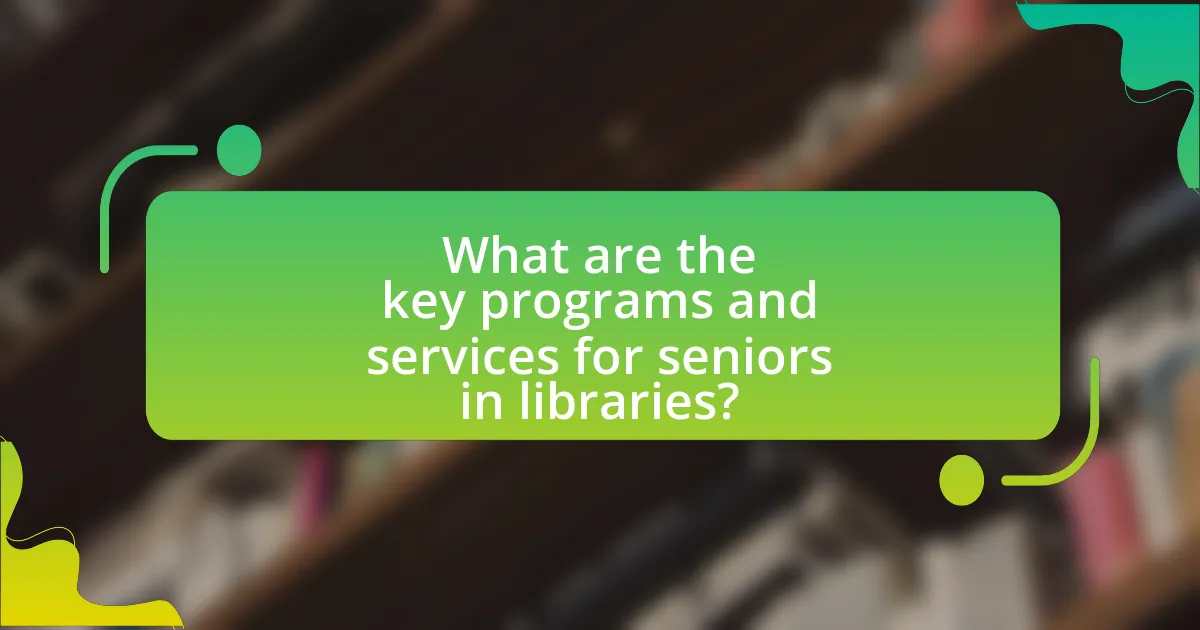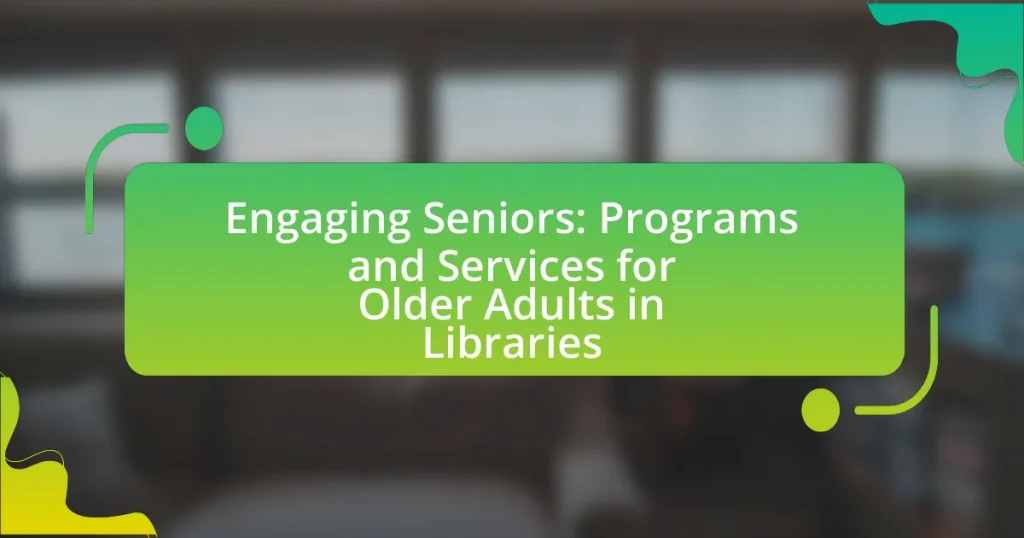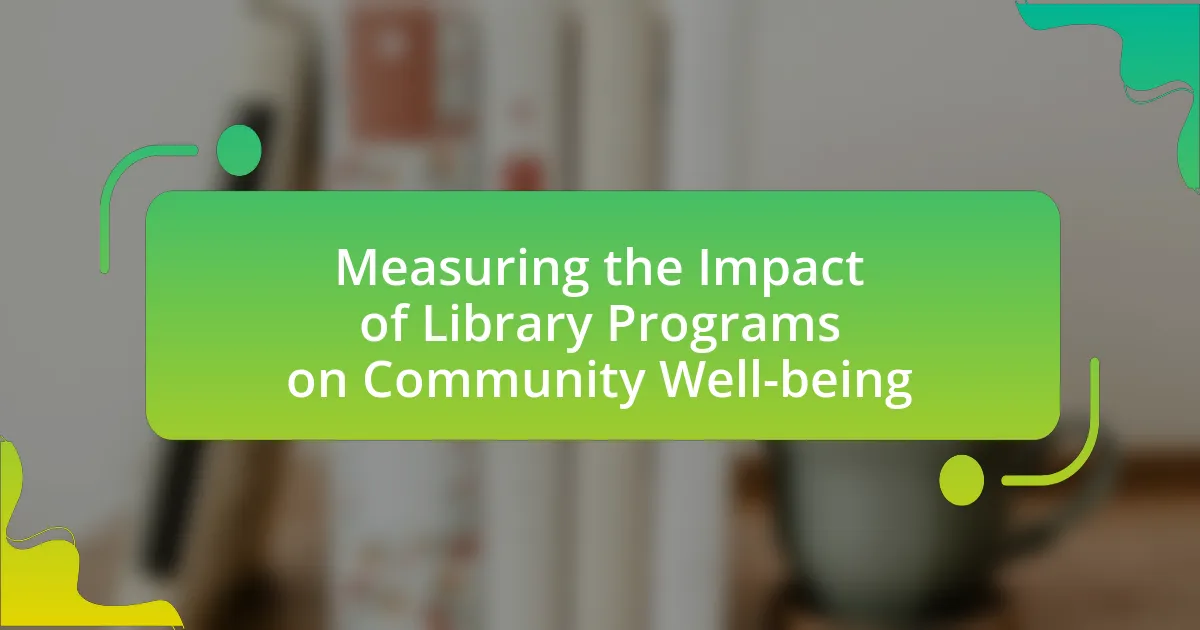The article focuses on the various programs and services offered by libraries to engage seniors, highlighting key initiatives such as digital literacy training, book clubs, health and wellness workshops, and social activities. It discusses how libraries tailor these programs to meet the specific needs of older adults, addressing challenges like technology barriers and social isolation. Additionally, the article examines the benefits of library programs for seniors, including enhanced social interaction, cognitive stimulation, and improved mental health. It also explores the importance of partnerships, volunteer involvement, and best practices for creating inclusive environments that foster senior participation in library services.

What are the key programs and services for seniors in libraries?
Key programs and services for seniors in libraries include digital literacy training, book clubs, health and wellness workshops, and social activities. Digital literacy training helps seniors navigate technology, enhancing their ability to access information and connect with others. Book clubs foster social interaction and intellectual engagement, while health and wellness workshops provide valuable information on topics relevant to older adults. Additionally, social activities, such as game days or crafting sessions, promote community building and reduce isolation among seniors. These programs are designed to meet the specific needs of older adults, ensuring they remain active and engaged in their communities.
How do libraries tailor their programs to meet the needs of older adults?
Libraries tailor their programs to meet the needs of older adults by offering specialized services such as technology training, health and wellness workshops, and social engagement activities. These programs are designed to address the unique challenges faced by older adults, including digital literacy gaps and social isolation. For instance, many libraries provide one-on-one assistance with devices and software, enabling seniors to navigate technology effectively. Additionally, health-related workshops often feature partnerships with local healthcare providers, ensuring that the information is relevant and beneficial. Research indicates that libraries that implement these targeted programs see increased participation from older adults, enhancing their overall quality of life and community involvement.
What types of activities are commonly offered to engage seniors?
Common activities offered to engage seniors include book clubs, arts and crafts, computer classes, exercise programs, and social events. Libraries often host book clubs that encourage reading and discussion, fostering social interaction among participants. Arts and crafts activities provide creative outlets, while computer classes help seniors develop digital literacy skills, which are increasingly important in today’s technology-driven world. Exercise programs, such as yoga or tai chi, promote physical health and well-being. Additionally, social events like game nights or movie screenings create opportunities for seniors to connect with others, reducing feelings of isolation. These activities are designed to enhance cognitive function, physical health, and social engagement among older adults.
How do these activities promote social interaction among older adults?
Activities in libraries, such as book clubs, workshops, and social events, promote social interaction among older adults by providing structured opportunities for engagement and connection. These activities facilitate conversations, foster friendships, and create a sense of community, which is essential for combating loneliness and isolation often experienced by seniors. Research indicates that participation in group activities can enhance social networks and improve mental well-being, as evidenced by a study published in the Journal of Gerontology, which found that older adults who engage in social activities report higher levels of life satisfaction and lower levels of depression.
What resources do libraries provide specifically for older adults?
Libraries provide a variety of resources specifically for older adults, including access to large print books, audiobooks, and digital resources tailored to their needs. Many libraries offer programs such as technology training sessions, book clubs, and health and wellness workshops designed to engage older adults and promote lifelong learning. Additionally, libraries often provide social activities and community events that foster connections among seniors, enhancing their social well-being. According to the American Library Association, 70% of public libraries offer programs specifically aimed at older adults, demonstrating their commitment to serving this demographic effectively.
How can seniors access technology training in libraries?
Seniors can access technology training in libraries through scheduled classes, one-on-one tutoring sessions, and online resources offered by library staff. Many libraries provide specific programs designed for older adults, often featuring beginner-friendly topics such as using smartphones, navigating the internet, and utilizing social media. According to the American Library Association, over 70% of public libraries offer technology training programs, highlighting their commitment to supporting seniors in developing digital skills.
What types of reading materials are available for older adults?
Older adults have access to a variety of reading materials, including large print books, audiobooks, e-books, magazines, newspapers, and specialized publications tailored to their interests. Libraries often provide large print books to accommodate visual impairments, while audiobooks offer an alternative for those who may have difficulty reading text. E-books can be accessed on tablets or e-readers, allowing for adjustable font sizes. Additionally, many libraries curate magazine and newspaper selections that focus on topics relevant to older adults, such as health, travel, and hobbies. These resources are designed to engage seniors and promote lifelong learning.

Why is it important to engage seniors in library programs?
Engaging seniors in library programs is important because it fosters social interaction, enhances cognitive skills, and promotes lifelong learning. Libraries serve as community hubs where older adults can connect with peers, reducing feelings of isolation and loneliness, which are prevalent among seniors. Research indicates that participation in library programs can improve mental health and well-being; for instance, a study published in the Journal of Applied Gerontology found that seniors who engaged in community activities reported higher levels of life satisfaction. Additionally, library programs often provide access to resources that support skill development and knowledge acquisition, which are crucial for maintaining cognitive function as people age.
What benefits do library programs offer to older adults?
Library programs offer older adults numerous benefits, including social engagement, access to information, and opportunities for lifelong learning. These programs foster community connections, reducing feelings of isolation by providing a space for social interaction and collaboration with peers. Additionally, libraries offer resources such as technology training and educational workshops, which help older adults stay informed and develop new skills. Research indicates that participation in library programs can enhance cognitive function and overall well-being among seniors, as evidenced by studies showing improved mental health outcomes linked to social activities and continued learning.
How do these programs contribute to mental health and well-being?
Programs and services for older adults in libraries contribute to mental health and well-being by providing social engagement, cognitive stimulation, and access to resources that promote emotional support. These programs, such as book clubs, workshops, and technology classes, foster community connections, reducing feelings of isolation and loneliness, which are significant risk factors for mental health issues among seniors. Research indicates that social interaction can enhance mood and cognitive function, with studies showing that participation in group activities can lead to improved mental health outcomes, such as reduced depression and anxiety levels. For instance, a study published in the Journal of Gerontology found that older adults who engaged in regular social activities reported higher levels of life satisfaction and lower levels of depressive symptoms.
In what ways do library services help combat social isolation among seniors?
Library services help combat social isolation among seniors by providing social engagement opportunities, access to resources, and community connections. Programs such as book clubs, technology classes, and social events encourage interaction among seniors, fostering relationships and reducing feelings of loneliness. Additionally, libraries offer resources like information on local services and activities that can help seniors connect with their communities. Research indicates that participation in library programs significantly enhances social networks for older adults, contributing to improved mental health and well-being.
How do libraries measure the success of their senior engagement programs?
Libraries measure the success of their senior engagement programs primarily through participant feedback, attendance metrics, and program outcomes. Participant feedback is collected via surveys and interviews, allowing libraries to assess satisfaction and areas for improvement. Attendance metrics track the number of seniors participating in programs, providing quantitative data on engagement levels. Additionally, libraries evaluate program outcomes by analyzing the impact on seniors’ social connections, cognitive engagement, and overall well-being, often supported by studies that demonstrate the benefits of library programs for older adults. For instance, a study by the American Library Association found that libraries significantly enhance social interaction among seniors, which is a key indicator of program success.
What metrics are used to evaluate participation and satisfaction?
Metrics used to evaluate participation and satisfaction in programs for older adults in libraries include attendance rates, participant feedback surveys, and engagement levels. Attendance rates measure the number of seniors participating in programs, providing a quantitative assessment of interest and reach. Participant feedback surveys collect qualitative data on satisfaction, allowing libraries to gauge the effectiveness of their offerings. Engagement levels, often assessed through follow-up interactions or participation in multiple programs, indicate the depth of involvement and ongoing interest among seniors. These metrics collectively inform libraries about the success of their initiatives and areas for improvement.
How can feedback from seniors improve library services?
Feedback from seniors can significantly improve library services by providing insights into their specific needs and preferences. Seniors often have unique requirements regarding accessibility, technology use, and program offerings, which can be identified through their feedback. For instance, a study by the American Library Association found that libraries that actively sought input from older adults were able to tailor their services, such as offering more digital literacy programs and accessible resources, leading to increased patron satisfaction and engagement. By incorporating this feedback, libraries can enhance their relevance and effectiveness in serving the senior community.

What challenges do libraries face in engaging seniors?
Libraries face several challenges in engaging seniors, primarily including accessibility, technology barriers, and program relevance. Accessibility issues arise from physical limitations that some seniors may have, making it difficult for them to visit libraries or participate in events. Technology barriers are significant, as many seniors may lack familiarity with digital tools and online resources that libraries increasingly offer. Additionally, program relevance is a challenge; libraries must ensure that their offerings resonate with the interests and needs of older adults, which can vary widely. According to a 2020 report by the American Library Association, only 30% of libraries have programs specifically tailored for seniors, highlighting the need for more targeted engagement strategies.
How do budget constraints affect senior programs in libraries?
Budget constraints significantly limit the availability and quality of senior programs in libraries. When libraries face reduced funding, they often have to cut back on resources such as staff, materials, and program offerings specifically designed for older adults. For instance, a study by the American Library Association found that 60% of libraries reported a decrease in programming for seniors due to budget cuts, leading to fewer workshops, classes, and social events that cater to this demographic. Consequently, the lack of financial resources directly impacts the ability of libraries to provide engaging and beneficial services for older adults, ultimately diminishing their role as community hubs for lifelong learning and social interaction.
What strategies can libraries implement to overcome funding issues?
Libraries can implement diverse strategies to overcome funding issues, including establishing partnerships with local organizations, applying for grants, and developing community fundraising initiatives. Collaborating with local businesses and nonprofits can create mutual benefits, such as shared resources and increased visibility, which can lead to financial support. Additionally, libraries can seek grants from government agencies and foundations specifically aimed at enhancing community services, with the Institute of Museum and Library Services providing over $200 million annually for such purposes. Furthermore, organizing fundraising events, such as book sales or community fairs, can engage the public and generate revenue while fostering community involvement. These strategies not only address immediate funding challenges but also build long-term sustainability for library programs and services.
How can libraries address accessibility concerns for older adults?
Libraries can address accessibility concerns for older adults by implementing physical modifications, providing specialized services, and offering technology training. Physical modifications include installing ramps, elevators, and accessible restrooms to ensure that older adults can navigate the library easily. Specialized services, such as home delivery of materials and personalized assistance, cater to the unique needs of older patrons. Additionally, technology training programs can help older adults become familiar with digital resources, enhancing their access to information. According to the American Library Association, libraries that adopt these strategies significantly improve engagement and service delivery for older adults, fostering an inclusive environment.
What partnerships can enhance library services for seniors?
Partnerships with local senior centers, healthcare providers, and community organizations can enhance library services for seniors. Collaborating with senior centers allows libraries to offer tailored programs that address the specific interests and needs of older adults, such as technology training or book clubs. Partnering with healthcare providers can facilitate health literacy workshops and access to resources on wellness and aging. Additionally, community organizations can help libraries reach a broader audience, promoting services and programs designed for seniors, thereby increasing participation and engagement. These partnerships leverage existing resources and expertise, creating a more supportive environment for seniors in the community.
How can collaboration with local organizations improve program offerings?
Collaboration with local organizations can significantly enhance program offerings by leveraging shared resources, expertise, and community connections. When libraries partner with local health services, senior centers, or educational institutions, they can create tailored programs that address the specific needs and interests of older adults. For instance, a study by the American Library Association found that libraries collaborating with local health organizations increased participation in health-related workshops by 40%, demonstrating the effectiveness of such partnerships in attracting seniors to relevant programming. This synergy not only enriches the library’s offerings but also fosters a sense of community engagement and support among older adults.
What role do volunteers play in supporting senior engagement initiatives?
Volunteers play a crucial role in supporting senior engagement initiatives by providing essential services and fostering social connections among older adults. They assist in organizing and facilitating programs tailored to the interests and needs of seniors, such as book clubs, technology training, and health workshops. Research indicates that volunteer involvement enhances the effectiveness of these initiatives, as seen in the “Engaging Seniors: Programs and Services for Older Adults in Libraries” report, which highlights that libraries with active volunteer programs report higher participation rates among seniors. This engagement not only enriches the lives of older adults but also strengthens community ties, demonstrating the significant impact of volunteers in these initiatives.
What are some best practices for engaging seniors in library programs?
To effectively engage seniors in library programs, libraries should prioritize accessibility, tailored programming, and community involvement. Accessibility ensures that programs are physically and technologically accommodating, such as providing transportation options and offering digital literacy workshops. Tailored programming, which includes book clubs, health seminars, and creative arts classes, addresses the specific interests and needs of seniors, fostering a sense of belonging and relevance. Community involvement, through partnerships with local organizations and senior centers, enhances outreach and encourages participation. Research indicates that libraries that implement these practices see increased attendance and satisfaction among senior patrons, demonstrating their effectiveness in fostering engagement.
How can libraries create inclusive environments for older adults?
Libraries can create inclusive environments for older adults by implementing accessible programs and services tailored to their needs. This includes offering technology training sessions, which help older adults navigate digital resources, as evidenced by a study from the Pew Research Center indicating that 73% of seniors express a desire to learn about technology. Additionally, libraries can provide comfortable seating areas and quiet spaces that accommodate mobility challenges and sensory sensitivities, enhancing the overall experience for older patrons. Furthermore, establishing partnerships with local senior organizations can facilitate outreach and ensure that library offerings align with the interests and preferences of older adults, fostering a sense of community and belonging.
What innovative approaches can libraries adopt to attract senior participation?
Libraries can attract senior participation by implementing technology training programs tailored for older adults. These programs can include workshops on using smartphones, tablets, and computers, which address the digital divide that many seniors face. According to a Pew Research Center study, 73% of seniors express a desire to learn more about technology, indicating a strong interest in such educational opportunities. Additionally, libraries can create social clubs or book discussion groups specifically for seniors, fostering community engagement and social interaction. Research from the National Institute on Aging shows that social participation can significantly enhance the well-being of older adults, further validating the effectiveness of these approaches.






